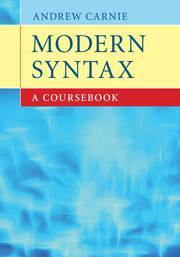
-
Select format
-
- Publisher:
- Cambridge University Press
- Publication date:
- 05 June 2012
- 13 January 2011
- ISBN:
- 9780511780738
- 9780521863353
- 9780521682046
- Dimensions:
- (247 x 174 mm)
- Weight & Pages:
- 0.9kg, 370 Pages
- Dimensions:
- (247 x 174 mm)
- Weight & Pages:
- 0.74kg, 370 Pages
- Subjects:
- Grammar and Syntax, Language and Linguistics
You may already have access via personal or institutional login- Subjects:
- Grammar and Syntax, Language and Linguistics
Book description
This practical coursebook introduces all the basics of modern syntactic analysis in a simple step-by-step fashion. Each unit is constructed so that the reader discovers new ideas, formulates hypotheses and practises fundamentals. The reader is presented with short sections of explanation with examples, followed by practice exercises. Feedback and comment sections follow to enable students to monitor their progress. No previous background in syntax is assumed. Students move through all the key topics in the field including features, rules of combination and displacement, empty categories, and subcategorization. The theoretical perspective in this work is unique, drawing together the best ideas from three major syntactic frameworks (minimalism, HPSG and LFG). Students using this book will learn fundamentals in such a way that they can easily go on to pursue further study in any of these frameworks.
Reviews
‘An ideal point of entry into the complex and challenging science of natural language syntax. Highly recommended.'
Cedric Boeckx - ICREA and Universitat Autònoma de Barcelona
‘This is a daring introduction into syntax. Rather than telling students what syntactic theory looks like, it makes them do syntax. Rather than presenting them with a standard framework, it provides students with the tools and knowledge to pursue any of the major theories. This is a friendly and experienced guide to the rough terrain and breathtaking vistas of modern syntactic theory.’
Ad Neeleman - Professor of Linguistics, University College London
Contents
Metrics
Full text views
Full text views help Loading metrics...
Loading metrics...
* Views captured on Cambridge Core between #date#. This data will be updated every 24 hours.
Usage data cannot currently be displayed.
Accessibility standard: Unknown
Why this information is here
This section outlines the accessibility features of this content - including support for screen readers, full keyboard navigation and high-contrast display options. This may not be relevant for you.
Accessibility Information
Accessibility compliance for the PDF of this book is currently unknown and may be updated in the future.


